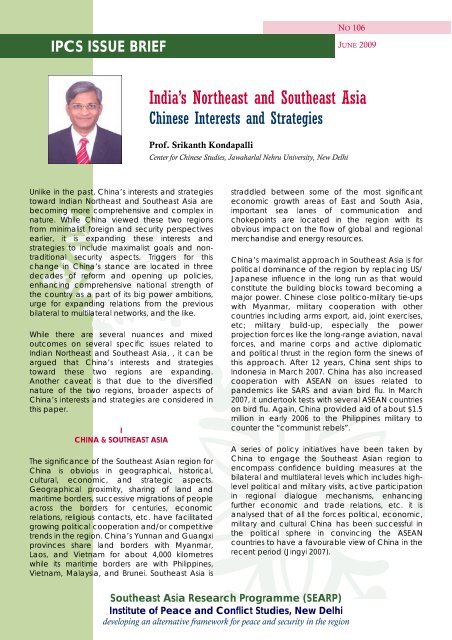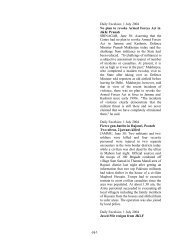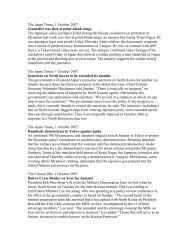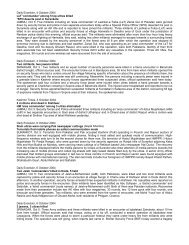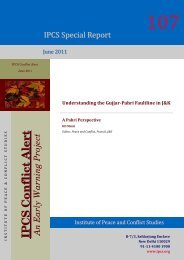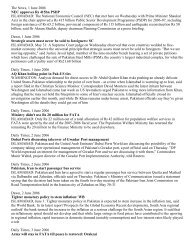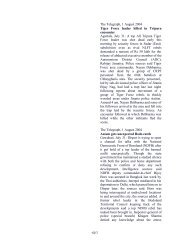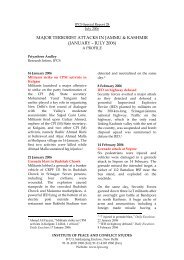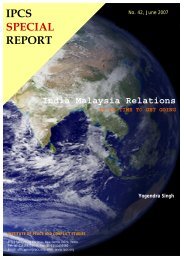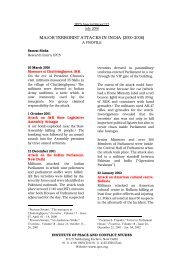India's Northeast and Southeast Asia - Institute of Peace and Conflict ...
India's Northeast and Southeast Asia - Institute of Peace and Conflict ...
India's Northeast and Southeast Asia - Institute of Peace and Conflict ...
You also want an ePaper? Increase the reach of your titles
YUMPU automatically turns print PDFs into web optimized ePapers that Google loves.
IPCS ISSUE BRIEF<br />
NO 106<br />
JUNE 2009<br />
India’s <strong>Northeast</strong> <strong>and</strong> <strong>Southeast</strong> <strong>Asia</strong><br />
Chinese Interests <strong>and</strong> Strategies<br />
Pr<strong>of</strong>. Srikanth Kondapalli<br />
Center for Chinese Studies, Jawaharlal Nehru University, New Delhi<br />
Unlike in the past, China’s interests <strong>and</strong> strategies<br />
toward Indian <strong>Northeast</strong> <strong>and</strong> <strong>Southeast</strong> <strong>Asia</strong> are<br />
becoming more comprehensive <strong>and</strong> complex in<br />
nature. While China viewed these two regions<br />
from minimalist foreign <strong>and</strong> security perspectives<br />
earlier, it is exp<strong>and</strong>ing these interests <strong>and</strong><br />
strategies to include maximalist goals <strong>and</strong> nontraditional<br />
security aspects. Triggers for this<br />
change in China’s stance are located in three<br />
decades <strong>of</strong> reform <strong>and</strong> opening up policies,<br />
enhancing comprehensive national strength <strong>of</strong><br />
the country as a part <strong>of</strong> its big power ambitions,<br />
urge for exp<strong>and</strong>ing relations from the previous<br />
bilateral to multilateral networks, <strong>and</strong> the like.<br />
While there are several nuances <strong>and</strong> mixed<br />
outcomes on several specific issues related to<br />
Indian <strong>Northeast</strong> <strong>and</strong> <strong>Southeast</strong> <strong>Asia</strong>, , it can be<br />
argued that China’s interests <strong>and</strong> strategies<br />
toward these two regions are exp<strong>and</strong>ing.<br />
Another caveat is that due to the diversified<br />
nature <strong>of</strong> the two regions, broader aspects <strong>of</strong><br />
China’s interests <strong>and</strong> strategies are considered in<br />
this paper.<br />
I<br />
CHINA & SOUTHEAST ASIA<br />
The significance <strong>of</strong> the <strong>Southeast</strong> <strong>Asia</strong>n region for<br />
China is obvious in geographical, historical,<br />
cultural, economic, <strong>and</strong> strategic aspects.<br />
Geographical proximity, sharing <strong>of</strong> l<strong>and</strong> <strong>and</strong><br />
maritime borders, successive migrations <strong>of</strong> people<br />
across the borders for centuries, economic<br />
relations, religious contacts, etc. have facilitated<br />
growing political cooperation <strong>and</strong>/or competitive<br />
trends in the region. China’s Yunnan <strong>and</strong> Guangxi<br />
provinces share l<strong>and</strong> borders with Myanmar,<br />
Laos, <strong>and</strong> Vietnam for about 4,000 kilometres<br />
while its maritime borders are with Philippines,<br />
Vietnam, Malaysia, <strong>and</strong> Brunei. <strong>Southeast</strong> <strong>Asia</strong> is<br />
straddled between some <strong>of</strong> the most significant<br />
economic growth areas <strong>of</strong> East <strong>and</strong> South <strong>Asia</strong>,<br />
important sea lanes <strong>of</strong> communication <strong>and</strong><br />
chokepoints are located in the region with its<br />
obvious impact on the flow <strong>of</strong> global <strong>and</strong> regional<br />
merch<strong>and</strong>ise <strong>and</strong> energy resources.<br />
China’s maximalist approach in <strong>Southeast</strong> <strong>Asia</strong> is for<br />
political dominance <strong>of</strong> the region by replacing US/<br />
Japanese influence in the long run as that would<br />
constitute the building blocks toward becoming a<br />
major power. Chinese close politico-military tie-ups<br />
with Myanmar, military cooperation with other<br />
countries including arms export, aid, joint exercises,<br />
etc; military build-up, especially the power<br />
projection forces like the long-range aviation, naval<br />
forces, <strong>and</strong> marine corps <strong>and</strong> active diplomatic<br />
<strong>and</strong> political thrust in the region form the sinews <strong>of</strong><br />
this approach. After 12 years, China sent ships to<br />
Indonesia in March 2007. China has also increased<br />
cooperation with ASEAN on issues related to<br />
p<strong>and</strong>emics like SARS <strong>and</strong> avian bird flu. In March<br />
2007, it undertook tests with several ASEAN countries<br />
on bird flu. Again, China provided aid <strong>of</strong> about $1.5<br />
million in early 2006 to the Philippines military to<br />
counter the “communist rebels”.<br />
A series <strong>of</strong> policy initiatives have been taken by<br />
China to engage the <strong>Southeast</strong> <strong>Asia</strong>n region to<br />
encompass confidence building measures at the<br />
bilateral <strong>and</strong> multilateral levels which includes highlevel<br />
political <strong>and</strong> military visits, active participation<br />
in regional dialogue mechanisms, enhancing<br />
further economic <strong>and</strong> trade relations, etc. it is<br />
analysed that <strong>of</strong> all the forces political, economic,<br />
military <strong>and</strong> cultural China has been successful in<br />
the political sphere in convincing the ASEAN<br />
countries to have a favourable view <strong>of</strong> China in the<br />
recent period (Jingyi 2007).<br />
<strong>Southeast</strong> <strong>Asia</strong> Research Programme (SEARP)<br />
<strong>Institute</strong> <strong>of</strong> <strong>Peace</strong> <strong>and</strong> <strong>Conflict</strong> Studies, New Delhi<br />
developing an alternative framework for peace <strong>and</strong> security in the region
INDIA’S NORTHEAST AND SOUTHEAST ASIA<br />
PAGE 2<br />
By 2002, China signed declarations <strong>of</strong> cooperation<br />
with the ASEAN <strong>and</strong> has either solved or in the<br />
process <strong>of</strong> solving l<strong>and</strong> <strong>and</strong> maritime disputes.<br />
While such “normalisation” <strong>of</strong> relations between<br />
China <strong>and</strong> <strong>Southeast</strong> <strong>Asia</strong>n countries has several<br />
other facets <strong>and</strong> differences, certain long-term<br />
underst<strong>and</strong>ing between the two is being worked<br />
out. China concluded a FTA with the ASEAN that is<br />
to be in place between 2010 <strong>and</strong> 2012, signed a<br />
treaty <strong>of</strong> amity <strong>and</strong> cooperation <strong>and</strong> tripartite<br />
agreement with Vietnam <strong>and</strong> Philippines on South<br />
China Sea dispute, initiated defence cooperative<br />
measures, etc. China assiduously kept away the<br />
US from the late 2005 Kuala Lumpur, January 2007<br />
Cebu <strong>and</strong> Singapore meetings <strong>of</strong> the East <strong>Asia</strong>n<br />
Summit, while its initial efforts to keep away India<br />
<strong>and</strong> others were unsuccessful due to the pressures<br />
<strong>of</strong> Singapore <strong>and</strong> Japan.<br />
China-ASEAN trade is more than $150 billion,<br />
making China the ASEAN’s fifth largest trading<br />
partner <strong>and</strong> ASEAN the sixth largest trading<br />
partner for China. To facilitate further trade<br />
between the two, China <strong>and</strong> the ASEAN countries<br />
have agreed to give shape to the 2000 proposal<br />
<strong>and</strong> set up an FTA in late 2002. If realised by 2010<br />
(for the older members <strong>of</strong> ASEAN <strong>and</strong> 2015 for its<br />
“new” members), this would be the world’s<br />
biggest such zone, with estimates <strong>of</strong> a combined<br />
market <strong>of</strong> 1.7 billion people, regional GDP <strong>of</strong> $2<br />
trillion <strong>and</strong> international trade worth $1.2 trillion,<br />
that would place FTA next only to the North<br />
American Free Trade Area <strong>and</strong> the European<br />
Union. It is proposed to remove all tariff <strong>and</strong> nontariff<br />
barriers to goods <strong>and</strong> services, <strong>and</strong> provide<br />
for preferential treatment to the “new” ASEAN<br />
members so that they could catch up<br />
economically with the rest. The next substantive<br />
step came in July 2005, when China-ASEAN<br />
agreed to implement goods trade agreement. In<br />
addition to reduction in tariffs in 2005, next year<br />
witnessed signing <strong>of</strong> free trade deals. Further, in<br />
January 2007, both agreed to cut barriers to trade<br />
in services such as transport, tourism, <strong>and</strong><br />
telecommunications.<br />
Another issue is the energy <strong>and</strong> trade<br />
dependence <strong>of</strong> China on <strong>Southeast</strong> <strong>Asia</strong>. This issue<br />
China’s maximalist approach in <strong>Southeast</strong> <strong>Asia</strong><br />
is for political dominance <strong>of</strong> the region by<br />
replacing US/Japanese influence in the long run<br />
as that would constitute the building blocks<br />
toward becoming a major power.<br />
has a potential to divide both India <strong>and</strong> China in<br />
the long term. Several Chinese reports indicate<br />
the concerns on Chinese dependence on the seal<br />
lanes <strong>of</strong> communications in <strong>Southeast</strong> <strong>Asia</strong>,<br />
specifically Straits <strong>of</strong> Malacca’s. In 2008 China<br />
imported about 180 million tonnes <strong>of</strong> oil, nearly 80<br />
percent <strong>of</strong> which passed through these Straits. In<br />
addition, burgeoning trade with South <strong>Asia</strong>n <strong>and</strong><br />
other countries is largely dependent on these<br />
Straits. Nearly 25 percent <strong>of</strong> global shipping passes<br />
through the South China Sea. Any disruptions to<br />
these supply lines could drastically affect the oil<br />
prices but also the economies <strong>of</strong> several countries.<br />
China is exploring alternate routes like access to<br />
the Indian Ocean through Myanmar. China<br />
concluded defence agreement with Malaysia<br />
<strong>and</strong> has been actively pursuing a “string <strong>of</strong> pearls”<br />
strategy in the Indian Ocean Region <strong>and</strong><br />
contiguous areas. However, some Chinese do<br />
recognise the Indian role in stabilising the situation.<br />
there is a possibility <strong>of</strong> cooperating with India in<br />
the fields <strong>of</strong> intelligence <strong>and</strong> technology to<br />
mitigate the challenges posed in the Straits.<br />
(Renfei 2004). Due to this, China conducted joint<br />
naval operations with India in November 2003 at<br />
Shanghai, December 2005 at Cochin, <strong>and</strong> regular<br />
port calls are being explored such as the Indian<br />
Naval visits to Qingdao in April 2007. Some believe<br />
that the launch <strong>of</strong> “string <strong>of</strong> pearls” strategy by<br />
China is to some extent linked to India’s Look East<br />
Policy (Khurana 2008). Besides, the Indian policy <strong>of</strong><br />
building a joint comm<strong>and</strong> at Andaman & Nicobar<br />
Isl<strong>and</strong>s has some bearing on the Chinese activity<br />
in <strong>Southeast</strong> <strong>Asia</strong>n region (Chaudhary 2007).<br />
II<br />
CHINA & INDIA’S NORTHEAST<br />
Distinct from the <strong>Southeast</strong> Region is the Indian<br />
<strong>Northeast</strong>, which is also contiguous to the southwestern<br />
regions <strong>of</strong> China. China’s interests <strong>and</strong><br />
strategies differ here on many issues, but<br />
fundamentally, sovereignty clashes over<br />
Arunachal Pradesh, national security concerns<br />
over indigenous peoples living in contiguous<br />
territories, etc remain similar. China’s interests in<br />
this region are broadly related to exp<strong>and</strong>ing<br />
physical connectivity, gaining access to the Indian<br />
Ocean, mitigating energy contingencies, <strong>and</strong><br />
evolving interdependencies for stabilising remote<br />
regions in the absence <strong>of</strong> progress in border talks<br />
with India. As a relatively more developed region,<br />
South-western portions <strong>of</strong> China could then have<br />
attained comm<strong>and</strong>ing position in this area. China<br />
had been assiduously exp<strong>and</strong>ing bilateral <strong>and</strong><br />
multilateral interactions in the region towards<br />
these objectives.<br />
IPCS ISSUE BRIEF
NO 106<br />
PAGE 3<br />
In order to realise this, China spearheaded in<br />
August 1999 the Kunming Initiative (Bangladesh-<br />
China-India-Myanmar grouping BCIM) with<br />
delegates from China, India, Myanmar <strong>and</strong><br />
Bangladesh participating. Subsequently, meetings<br />
were held at the respective capitals <strong>of</strong> these<br />
countries focusing on infrastructure development<br />
projects, tourism, economic development, etc.<br />
While China, Myanmar <strong>and</strong> Bangladesh<br />
appeared to stress Track 1 level, India prefers a<br />
Track 2 dialogue process underling the latter’s<br />
reservations.<br />
The BCIM area is about 2.12 million sq. km. (<strong>of</strong><br />
which the Indian northeast is about 255,000 sq.<br />
km) with a population <strong>of</strong> about 400 million (<strong>of</strong><br />
which there were about 30 million in the Indian<br />
north-east) <strong>and</strong> abundant natural resources<br />
connecting the under-developed markets <strong>of</strong> the<br />
Indian sub-continent with China <strong>and</strong> South East<br />
<strong>Asia</strong>. The “complementary” role <strong>of</strong> Chinese south<br />
western resources (metallurgy, chemical,<br />
electromechanical, textile, tobacco, paper<br />
making, etc) with that <strong>of</strong> the Indian northeast<br />
potential (in minerals, agriculture, aquaculture<br />
<strong>and</strong> electronics), Myanmar (l<strong>and</strong>, forests, oil,<br />
precious stones) <strong>and</strong> Bangladesh (natural gas,<br />
coal, water resources, garments) are stressed in<br />
this grouping.<br />
Domestic business <strong>and</strong> political considerations in<br />
China preceded the BCIM proposal. Chinese<br />
south-western provinces <strong>of</strong> Sichuan <strong>and</strong> Yunnan<br />
are in the throes <strong>of</strong> modernizing their economies.<br />
However the Sichuan initiative was lost (along with<br />
nearly 5 million migrant labourers) to the Special<br />
Economic Zones in the South-eastern Coastal<br />
Regions which is suitable for the export-oriented<br />
economic model. Nevertheless, following the<br />
current drive to open up the western regions the<br />
investment climate has been slowly shifting<br />
towards these south-western provinces. In<br />
addition, the State Owned Enterprises are either<br />
being consolidated into large groupings or are<br />
being sold to private entrepreneurs in the process<br />
<strong>of</strong> marketization. A large private entrepreneurs’<br />
exhibition was held at Kunming in 2001 for further<br />
development <strong>of</strong> the region. In this context, a<br />
railway line proposal linking interior south-western<br />
provinces to the nearest coastal regions<br />
(Myanmar, etc) for further export was made in<br />
1995 at the National People’s Congress in Beijing<br />
(coincidentally after China’s military Logistics<br />
Director Gen. Zhao Nanqi questioned whether<br />
Indian Ocean is India’s ocean in 1993!). It was<br />
argued that a railway line would be able to<br />
exp<strong>and</strong> trade volume, especially in iron <strong>and</strong><br />
phosphorous imports, as such current trade<br />
(conducted by the medium <strong>and</strong> low level trading<br />
China’s interests <strong>and</strong> strategies in India’s<br />
<strong>Northeast</strong> differ on many issues, but<br />
fundamentally, sovereignty clashes over<br />
Arunachal Pradesh, national security concerns<br />
over indigenous peoples living in contiguous<br />
territories, etc remain similar<br />
companies) is uneconomical by sea. Close<br />
economic <strong>and</strong> political cooperation between<br />
China <strong>and</strong> Myanmar resulted in developing roads<br />
<strong>and</strong> waterways from Yunnan to the Indian Ocean<br />
through the Irrawaddy River. Two railway routes<br />
identified include: Dali (Yunnan)- Tengchong <strong>and</strong><br />
Myitkyina (Myanmar)- Ledo (India); <strong>and</strong> Xiangyun<br />
<strong>and</strong> Ruili (Yunnan) - Lashio <strong>and</strong> M<strong>and</strong>alay<br />
(Myanmar) - Chittagong <strong>and</strong> Dhaka (Bangladesh)<br />
– Calcutta (India).<br />
The roadway construction project plans include<br />
the following: 1,472 km Ruili (Yunnan)- Bamuo to<br />
Rangoon (Myanmar); 540 km Heinnitang to<br />
Myitkyina- Stilwell Raod to Ledo (India); 730 km<br />
Ruili to Bamuo <strong>and</strong> Myitkyina to Stilwell Road to<br />
Ledo; 770 km Ruili to Bamuo <strong>and</strong> Tamu (Myanmar)<br />
to Imphal (India); Nagal<strong>and</strong> (India) – Myanmar;<br />
<strong>and</strong> India-China road - 200 kms <strong>of</strong> the Gongshang<br />
county (Yunnan) to Gecha county (Tibet) [built by<br />
1999] <strong>and</strong> about 200 kms from Chayu county<br />
(Tibet) to Lido (India) [incomplete]. The waterways<br />
projects include: Through Ilowai River from Yunnan<br />
to Muse to Bamuo port [length 1,563 km. <strong>and</strong><br />
width 600 meters; h<strong>and</strong>ling capacity 3.9 million<br />
tons] in Myanmar.<br />
Chinese <strong>of</strong>ficials assume that this economic<br />
cooperation would lead to “unity <strong>of</strong> the<br />
developing countries <strong>and</strong> [their] joint fight against<br />
hegemonies” <strong>and</strong> contribute to “establishing the<br />
new-multi-polar world order <strong>and</strong> safeguard<br />
[emphasis added] the peace <strong>and</strong> stability <strong>of</strong> <strong>Asia</strong><br />
<strong>and</strong> the world”. Upon the realization <strong>of</strong> the<br />
economic benefits flowing from these<br />
cooperative efforts, the four countries, according<br />
to Lai Xiaorong, are to set up a “companionship<br />
facing the 21st century”. In this context, an <strong>Asia</strong>n<br />
Forum was formed at Bo Ao in Hainan Province in<br />
2001 (attended by other members like Myanmar,<br />
Bangladesh, Pakistan <strong>and</strong> Nepal, though Indian<br />
Embassy <strong>of</strong>ficials at Beijing or New Delhi ignored<br />
the meeting initially). Broadly, this framework fits<br />
into the Chinese government’s overall strategic<br />
considerations <strong>of</strong> complete “normalization” in all<br />
fields <strong>of</strong> economic, social, <strong>and</strong> political aspects<br />
prior to solving the border problem with India.<br />
Development <strong>of</strong> infrastructure, especially transport<br />
routes, have been one <strong>of</strong> the crucial aspects <strong>of</strong><br />
SOUTHEAST ASIA RESEARCH PROGRAMME (SEARP)
INDIA’S NORTHEAST AND SOUTHEAST ASIA PAGE 4<br />
the BCIM agenda. The Trans <strong>Asia</strong>n Highway (TAH)<br />
was conceived in 1960 <strong>and</strong> has about 25 member<br />
countries with three (including Russia <strong>and</strong> Korea)<br />
expected to join in the near future. Its length is<br />
about 15,000 km. The Trans <strong>Asia</strong>n Railway (TAR)<br />
was conceived in 1959. However both TAH <strong>and</strong><br />
TAR faced problems with the outbreak <strong>of</strong><br />
Vietnam, Cambodian, Iran, <strong>and</strong> Iraq wars. A fresh<br />
impetus was given in the 1980s. However, BCIM<br />
has proposed several alternate routes from the<br />
one existing but under repair or at places missing.<br />
Bangladesh has proposed a short route that<br />
reduces the railway line by about 400 km from<br />
Kunming via Imphal to Dhaka. Huge investments<br />
are required either to construct or upgrade the<br />
TAH/TAR. As there is no significant trade in this<br />
region, the infrastructure cost may act as a<br />
deterrent for its further progress. Other related<br />
projects include those connecting to <strong>Southeast</strong><br />
<strong>Asia</strong>: Kunming to Singapore; Bangkok highway<br />
from Kunming (to be built by 2005); Lunming to<br />
Laos, etc. In this context the Indian government<br />
has shown some interest in the infrastructure<br />
development projects. The Shukla Commission<br />
Report [“Transforming the <strong>Northeast</strong>”] <strong>of</strong> March<br />
1977 advocated the concept <strong>of</strong> constructing a<br />
Trans-<strong>Asia</strong>n highway <strong>and</strong> railway linking Indian<br />
northeast with China through Myanmar. The BRO<br />
has constructed the 160 km Tamu-Kalewa-<br />
Kalemayo road at a cost <strong>of</strong> Rs 92 crores<br />
connecting Myanmar.<br />
Trade that follows from the construction <strong>of</strong><br />
transport routes is another area <strong>of</strong> concern for the<br />
BCIM. The <strong>of</strong>ficial trade figures among these<br />
countries reveal a definite rise. For instance, Indo–<br />
Myanmmar trade increased from Rs 444 cr in 1993-<br />
94 to about $995 million in 2008. Similarly, Indo-<br />
Bangladesh trade increased from Rs 1050 cr in<br />
1992-93 to $3.6 billion in 2008 <strong>and</strong> India-China<br />
trade from a nominal $ 3.5 billion in 2001 reached<br />
$50 billion in 2008. In the approximate border<br />
trade figures there has been significant un<strong>of</strong>ficial<br />
trade between India-Myanmar <strong>and</strong> Bangladesh.<br />
Through Moreh to Myanmmar the un<strong>of</strong>ficial trade<br />
figures are about Rs 2000 cr per annum, Champai<br />
<strong>and</strong> Lungwah to Myanmmar is about Rs 500 cr<br />
<strong>and</strong> 100 cr respectively <strong>and</strong> through West Bengal<br />
<strong>and</strong> Tripura to Bangladesh its Rs 1165 crores.<br />
IV<br />
CONCLUSIONS<br />
China is today facing several bottlenecks in<br />
pursuing its interests in <strong>Southeast</strong> <strong>Asia</strong> <strong>and</strong> in<br />
<strong>Northeast</strong> India. As mentioned earlier in this article,<br />
sovereignty factor had been important for the<br />
relative stalemate between China <strong>and</strong> these<br />
countries. Due to differences between the ASEAN<br />
members, China had been so far able to make<br />
some headway on South China Sea dispute. Not<br />
much progress have achieved in the Indian<br />
<strong>Northeast</strong> case due to security concerns <strong>of</strong> the<br />
Indian establishment as well as non-resolution <strong>of</strong><br />
border disputes. While the local government in<br />
Arunachal Pradesh had suggested opening up<br />
border trade points with Tibet, this was not<br />
acceptable to China. On the other h<strong>and</strong>, India is<br />
wary <strong>of</strong> the dependencies <strong>of</strong> the <strong>Northeast</strong><br />
Region given the relatively industrialised<br />
Southwestern Regions <strong>of</strong> China. In this situation,<br />
India had proposed direct links with <strong>Southeast</strong> <strong>Asia</strong><br />
(through Myanmar) or through the maritime<br />
dimensions rather than linking up with China. On<br />
the other h<strong>and</strong>, China has been lukewarm to the<br />
Indian proposals for pan-<strong>Asia</strong>n FTA as this might<br />
enhance Japan, Singapore, <strong>and</strong> other countries’<br />
leverages. Overall, despite the prospects for<br />
increasing trade <strong>and</strong> economic development,<br />
China’s interactions with <strong>Southeast</strong> <strong>Asia</strong> <strong>and</strong><br />
Indian northeast are fuelling concerns in some<br />
quarters <strong>of</strong> these regions.<br />
REFERENCES<br />
Zhang Lianfu <strong>and</strong> Pei Zhengxuan “21 shiji de Zhongguo<br />
yu Dongmeng guojia guanxi jiyu, tiaozhan,<br />
qianqing” [The relationship between China <strong>and</strong> ASEAN<br />
nations in the 21st Century: Opportunity, challenges <strong>and</strong><br />
prospects] Chaohu xueyan xuebao [Chaohu College<br />
Journal] 8.2.77. (2006): pp. 26-29.<br />
Xu Jingyi. “Lengzhan hou Zhongguo zai Dongnanya diqu<br />
shili yunyong: Zhongguo yu Dongmeng waijiao” [China’s<br />
wielding <strong>of</strong> strength in <strong>Southeast</strong> <strong>Asia</strong> in the post-Cold<br />
War: The foreign policy <strong>of</strong> China <strong>and</strong> ASEAN] Zhonggong<br />
Shijiazhuang Weidangxiao Xuebao [Journal <strong>of</strong> the Party<br />
University <strong>of</strong> Shijiazhuang Committee <strong>of</strong> the Communist<br />
Party] 9.4. (2007) pp. 29-32.<br />
“ASEAN, China agree to cut trade barriers” http://<br />
money.netscape.com/story/2007/01/14/asean-chinaagree-to-cut-trade-barriers<br />
Yang Renfei, “Maliujia haidao wentide zui xin fazhan ji dui<br />
Nanhai wenti de qishi” [Latest developments <strong>of</strong> the<br />
Malacca Straits issue <strong>and</strong> its inspiration for the South<br />
China issue] Dongnanya Zongheng [Around <strong>Southeast</strong><br />
<strong>Asia</strong>] (September 2004) pp. 38-42 <strong>and</strong> 54<br />
Gurpreet S. Khurana, “ China’s ‘String <strong>of</strong> Pearls’ in the<br />
Indian Ocean <strong>and</strong> Its Security Implications” Strategic<br />
Analysis, 32, No. 1, (January 2008) pp. 1-39<br />
SOUTHEAST ASIA<br />
RESEARCH PROGRAMME (SEARP)<br />
INSTITUTE OF PEACE AND CONFLICT STUDIES<br />
B-7/3, Safdarjung Enclave, New Delhi, India,<br />
110029, Tel: 91-11-4100 1900<br />
SEARP is supported by the SAEA Group,<br />
Singapore


